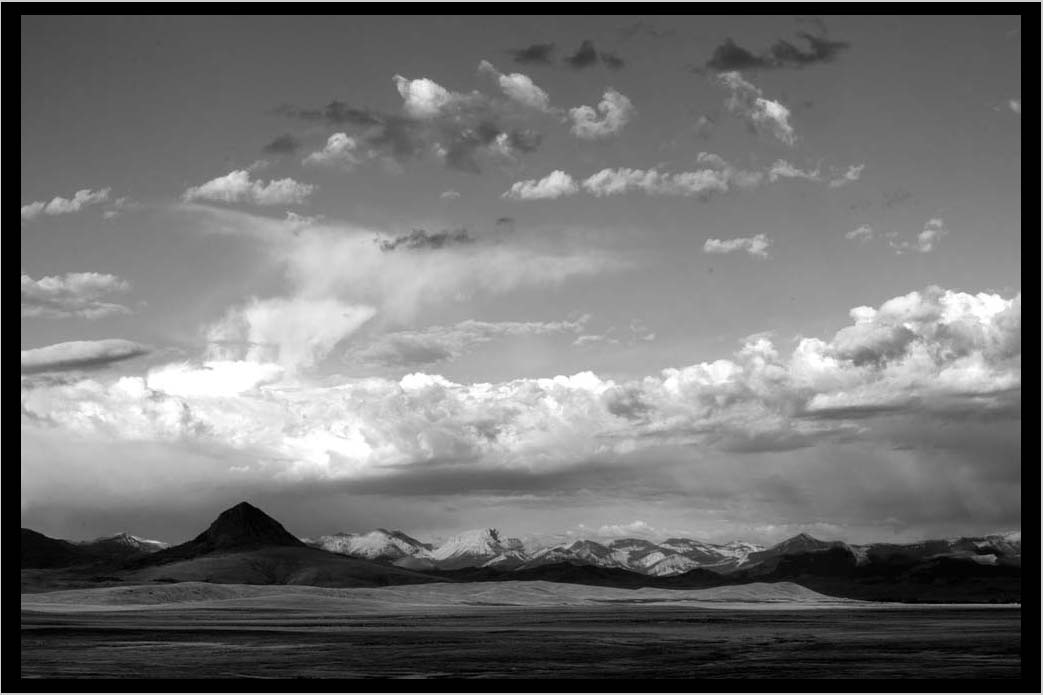

ROCKY MOUNTAIN FRONT—looking West, South of Augusta, Montana. [click photo for next . . . ]
On the road in the American Northwest.


ROCKY MOUNTAIN FRONT—looking West, South of Augusta, Montana. [click photo for next . . . ]
On the road in the American Northwest.
ON THE LOSS OF RHYTHM
The body of contemporary Western culture is but half a body, divided
or cut off at the waist, centered not in the heart, or solar plexus, but in
the eyes. Sitting at the controls is this halfbody’s activity of choice. In
front of the TV, the computer, or steering wheel of a car.
But what of the poor feet? They might tell us that one cannot think
clearly about much of anything—especially dance, or music, or
poetry—without living a life deeply grounded in the slow, measured
cadence of walking.
Witness the automobile: so utterly without rhythm; it simply wishes to
continue without interruption on its smooth, mechanical trajectory . . .
And so, our sense of rhythm, of movements of all kinds large and
small, is quickly falling by the wayside, conditioned deeply by machines
like the automobile, and atrophying like muscles or organs we
no longer need or use.
And so, we get bored. Bored for lack of rhythm. Indeed, boredom has
become a key feature of this culture of the halfbody, a state which we
seek to escape remarkably by more sitting in front of ever-more
sophisticated controls.
THOUGHT EXPERIMENTS OF THE
COMPASSIONATE MIND
A key feature of the compassionate mind is evidently its need to move
freely with the unseen relational resonances implicit in every produced
or used artifact, every thought, every action. The apple may indeed
be superficially beautiful, but to ask how, where and by whom it was
grown, is a quintessentially spiritual question.
For the student of any age, the key thought experiment is: begin with
the end, or manufactured object, and then unravel it into its many
simpler constituent threads or parts, thereby going back in time and
space like a movie playing backwards. Imagine all the objects in a room
returning to their ultimate earth-bound source in this way. And then, run
the movie in your mind’s eye fast-forward until all the objects converge
again into their motionless, present form.
What parts of the movement are necessarily so? What parts are wasteful?
What parts cause harm? Which objects do you now see as necessary?
Which do you see as wasteful?
It is the beginning of a much wider circle of ethical awareness.
FREEDOM & LIMITS
Highways exist to move traffic,
As Internets exist to move bits,
And Economies to move goods.
All three are paths of movement,
of exchange, of communication.
And with all three, freedom flourishes
only when it is strictly limited by universal,
clear, unambiguous laws.
Without clear limits, the worst and most brutish
of our natural tendencies shall come to rule
the many roads that run between us.
THE WONDER OF WALKING
In the mountains,
one may go up a climber,
but always comes down a pilgrim.
RETRONYMS?
Retronyms? With every step we take away from the wisdom of Nature’s
way, the more difficult it becomes to clearly see what we have lost or
left behind. Acoustic guitar, organic tomato, and—as a possible future,
n a t u r a l human being. Once the crucial sensitivity threshold is crossed
and we can only with difficulty distinguish the artificial, industrial mimics
from their originals, what then? Imagine sitting at a restaurant table,
and a guy asks, “Hey, the girl at the end of the bar, is she...?”
NOTATION & THE KNOWN
To really hear, or listen, is to forget for a moment the notation—
whether it be words and letters, numbers and equations, or
the notes of a musical score—we use to think about things
when we write them down.
In this way, perception is unconditioned by the fetters of
the past, and therefore open to the energy of new insight.
It is a great art to be free for a moment, as a kind of
meditation, of all measure, of all art.
|
| download Six MINIATURES mp3 [14Mb]
THE LITTLE CLAVIER please preview 150 of 631 pages
w/ my black & white photography [opens in new window]
Follow @cliffcrego
Featured gallery, 100 MINIATURES, a set of 100 black & white photographs. ONE image. ONE idea. ONE new way of looking . . .100 MINIATURES—online gallery
Each miniature is a kind of meditation on one idea & one image;
Each lasts 30 seconds; They play in random order;
The music is my BOREA Mix,
for hand-played ePecussion Orchestra.
[ mouse over for controls / lower right fro full-screen ]
All Photographs & texts by Cliff Crego © 1998-2016 picture-poems.com
(created: VII.25.2009)